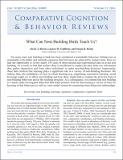Files in this item
What can nest-building birds teach us?
Item metadata
| dc.contributor.author | Breen, Alexis J. | |
| dc.contributor.author | Guillette, Lauren Mary | |
| dc.contributor.author | Healy, Susan Denise | |
| dc.date.accessioned | 2016-06-20T11:30:12Z | |
| dc.date.available | 2016-06-20T11:30:12Z | |
| dc.date.issued | 2016 | |
| dc.identifier | 241881167 | |
| dc.identifier | d69edc03-ea4f-406e-aba4-0e5750dc20a6 | |
| dc.identifier | 85017093632 | |
| dc.identifier | 000388598600005 | |
| dc.identifier.citation | Breen , A J , Guillette , L M & Healy , S D 2016 , ' What can nest-building birds teach us? ' , Comparative Cognition & Behavior Reviews , vol. 11 , pp. 83-102 . https://doi.org/10.3819/ccbr.2016.110005 | en |
| dc.identifier.issn | 1911-4745 | |
| dc.identifier.other | ORCID: /0000-0002-8059-4480/work/60631259 | |
| dc.identifier.uri | https://hdl.handle.net/10023/9017 | |
| dc.description | We thank the School of Biology at the University of St Andrews for funding (AJB) and the BBSRC (LMG: BB/M013944/1 and SDH: BB/I019634/1). | en |
| dc.description.abstract | For many years nest building in birds has been considered a remarkable behaviour. Perhaps just as remarkable is the public and scholarly consensus that bird nests are achieved by instinct alone. Here we take the opportunity to review nearly 150 years of observational and experimental data on avian nest building. As a result we find that instinct-alone is insufficient to explain the data: birds use information they gather themselves and from other individuals to make nest-building decisions. Importantly, these data confirm that learning plays a significant role in a variety of nest-building decisions. We outline, then, the multiplicity of ways in which learning (e.g., imprinting, associative learning, social learning) might act to affect nest building and how these might help to explain the diversity both of nest-building behaviour and in the resulting structure. As a consequence, we contend that nest building is a much under-investigated behaviour that holds promise both for determining a variety of roles for learning in that behaviour as well as a new model system for examining brain-behaviour relationships. | |
| dc.format.extent | 2821187 | |
| dc.language.iso | eng | |
| dc.relation.ispartof | Comparative Cognition & Behavior Reviews | en |
| dc.subject | Nest building | en |
| dc.subject | Learning | en |
| dc.subject | Cognition | en |
| dc.subject | Comparative cognition | en |
| dc.subject | Birds | en |
| dc.subject | QH301 Biology | en |
| dc.subject | QL Zoology | en |
| dc.subject.lcc | QH301 | en |
| dc.subject.lcc | QL | en |
| dc.title | What can nest-building birds teach us? | en |
| dc.type | Journal article | en |
| dc.contributor.sponsor | BBSRC | en |
| dc.contributor.sponsor | BBSRC | en |
| dc.contributor.sponsor | BBSRC | en |
| dc.contributor.institution | University of St Andrews. School of Biology | en |
| dc.contributor.institution | University of St Andrews. Centre for Social Learning & Cognitive Evolution | en |
| dc.contributor.institution | University of St Andrews. Institute of Behavioural and Neural Sciences | en |
| dc.contributor.institution | University of St Andrews. Centre for Biological Diversity | en |
| dc.identifier.doi | 10.3819/ccbr.2016.110005 | |
| dc.description.status | Peer reviewed | en |
| dc.identifier.url | http://comparative-cognition-and-behavior-reviews.org/2016/vol11_breen_guillette_healy/ | en |
| dc.identifier.grantnumber | BB/I019502/1 | en |
| dc.identifier.grantnumber | BB/M013944/1 | en |
| dc.identifier.grantnumber | BB/I019502/1 | en |
This item appears in the following Collection(s)
Items in the St Andrews Research Repository are protected by copyright, with all rights reserved, unless otherwise indicated.

